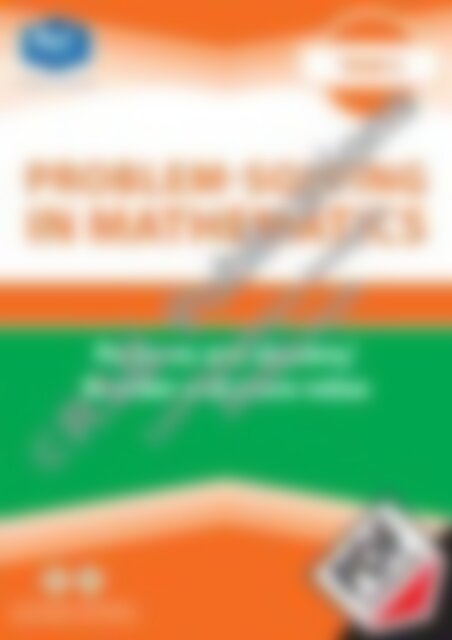20764_Problem_solving_Year_5_Patterns_and_algebra_Number_and_place_value
Create successful ePaper yourself
Turn your PDF publications into a flip-book with our unique Google optimized e-Paper software.
Your partner in education<br />
YEAR 5<br />
PROBLEM-SOLVING<br />
IN MATHEMATICS<br />
<strong>Patterns</strong> <strong>and</strong> <strong>algebra</strong>/<br />
<strong>Number</strong> <strong>and</strong> <strong>place</strong> <strong>value</strong><br />
Two-time winner of the Australian<br />
Primary Publisher of the <strong>Year</strong> Award
<strong>Problem</strong>-<strong>solving</strong> in mathematics<br />
(Book F)<br />
Published by R.I.C. Publications ® 2008<br />
Copyright © George Booker <strong>and</strong><br />
Denise Bond 2008<br />
RIC–<strong>20764</strong><br />
This master may only be reproduced by the<br />
original purchaser for use with their class(es). The<br />
publisher prohibits the loaning or onselling of this<br />
master for the purposes of reproduction.<br />
Copyright Notice<br />
Blackline masters or copy masters are published <strong>and</strong><br />
sold with a limited copyright. This copyright allows<br />
publishers to provide teachers <strong>and</strong> schools with a<br />
wide range of learning activities without copyright<br />
being breached. This limited copyright allows the<br />
purchaser to make sufficient copies for use within<br />
their own education institution. The copyright is not<br />
transferable, nor can it be onsold. Following these<br />
instructions is not essential but will ensure that you,<br />
as the purchaser, have evidence of legal ownership<br />
to the copyright if inspection occurs.<br />
For your added protection in the case of copyright<br />
inspection, please complete the form below. Retain<br />
this form, the complete original document <strong>and</strong> the<br />
invoice or receipt as proof of purchase.<br />
Name of Purchaser:<br />
Date of Purchase:<br />
Supplier:<br />
School Order# (if applicable):<br />
Signature of Purchaser:<br />
Internet websites<br />
In some cases, websites or specific URLs may be recommended. While these are checked <strong>and</strong> rechecked at the time of publication,<br />
the publisher has no control over any subsequent changes which may be made to webpages. It is strongly recommended that the class<br />
teacher checks all URLs before allowing students to access them.<br />
View all pages online<br />
PO Box 332 Greenwood Western Australia 6924<br />
Website: www.ricpublications.com.au<br />
Email: mail@ricgroup.com.au
FOREWORD<br />
Books A–G of <strong>Problem</strong>-<strong>solving</strong> in mathematics have been developed to provide a rich resource for teachers<br />
of students from the early years to the end of middle school <strong>and</strong> into secondary school. The series of problems,<br />
discussions of ways to underst<strong>and</strong> what is being asked <strong>and</strong> means of obtaining solutions have been built up to<br />
improve the problem-<strong>solving</strong> performance <strong>and</strong> persistence of all students. It is a fundamental belief of the authors<br />
that it is critical that students <strong>and</strong> teachers engage with a few complex problems over an extended period rather than<br />
spend a short time on many straightforward ‘problems’ or exercises. In particular, it is essential to allow students<br />
time to review <strong>and</strong> discuss what is required in the problem-<strong>solving</strong> process before moving to another <strong>and</strong> different<br />
problem. This book includes extensive ideas for extending problems <strong>and</strong> solution strategies to assist teachers in<br />
implementing this vital aspect of mathematics in their classrooms. Also, the problems have been constructed <strong>and</strong><br />
selected over many years’ experience with students at all levels of mathematical talent <strong>and</strong> persistence, as well as<br />
in discussions with teachers in classrooms, professional learning <strong>and</strong> university settings.<br />
<strong>Problem</strong>-<strong>solving</strong> does not come easily to most people,<br />
so learners need many experiences engaging with<br />
problems if they are to develop this crucial ability. As<br />
they grapple with problem, meaning <strong>and</strong> find solutions,<br />
students will learn a great deal about mathematics<br />
<strong>and</strong> mathematical reasoning; for instance, how to<br />
organise information to uncover meanings <strong>and</strong> allow<br />
connections among the various facets of a problem<br />
to become more apparent, leading to a focus on<br />
organising what needs to be done rather than simply<br />
looking to apply one or more strategies. In turn, this<br />
extended thinking will help students make informed<br />
choices about events that impact on their lives <strong>and</strong> to<br />
interpret <strong>and</strong> respond to the decisions made by others<br />
at school, in everyday life <strong>and</strong> in further study.<br />
Student <strong>and</strong> teacher pages<br />
The student pages present problems chosen with a<br />
particular problem-<strong>solving</strong> focus <strong>and</strong> draw on a range<br />
of mathematical underst<strong>and</strong>ings <strong>and</strong> processes.<br />
For each set of related problems, teacher notes <strong>and</strong><br />
discussion are provided, as well as indications of<br />
how particular problems can be examined <strong>and</strong> solved.<br />
Answers to the more straightforward problems <strong>and</strong><br />
detailed solutions to the more complex problems<br />
ensure appropriate explanations, the use of the<br />
pages, foster discussion among students <strong>and</strong> suggest<br />
ways in which problems can be extended. Related<br />
problems occur on one or more pages that extend the<br />
problem’s ideas, the solution processes <strong>and</strong> students’<br />
underst<strong>and</strong>ing of the range of ways to come to terms<br />
with what problems are asking.<br />
At the top of each teacher page, there is a statement<br />
that highlights the particular thinking that the<br />
problems will dem<strong>and</strong>, together with an indication<br />
of the mathematics that might be needed <strong>and</strong> a list<br />
of materials that could be used in seeking a solution.<br />
A particular focus for the page or set of three pages<br />
of problems then exp<strong>and</strong>s on these aspects. Each<br />
book is organised so that when a problem requires<br />
complicated strategic thinking, two or three problems<br />
occur on one page (supported by a teacher page with<br />
detailed discussion) to encourage students to find<br />
a solution together with a range of means that can<br />
be followed. More often, problems are grouped as a<br />
series of three interrelated pages where the level of<br />
complexity gradually increases, while the associated<br />
teacher page examines one or two of the problems in<br />
depth <strong>and</strong> highlights how the other problems might be<br />
solved in a similar manner.<br />
R.I.C. Publications ® www.ricpublications.com.au <strong>Problem</strong>-<strong>solving</strong> in mathematics<br />
iii
FOREWORD<br />
Each teacher page concludes with two further aspects<br />
critical to successful teaching of problem-<strong>solving</strong>. A<br />
section on likely difficulties points to reasoning <strong>and</strong><br />
content inadequacies that experience has shown may<br />
well impede students’ success. In this way, teachers<br />
can be on the look out for difficulties <strong>and</strong> be prepared<br />
to guide students past these potential pitfalls. The<br />
final section suggests extensions to the problems to<br />
enable teachers to provide several related experiences<br />
with problems of these kinds in order to build a rich<br />
array of experiences with particular solution methods;<br />
for example, the numbers, shapes or measurements<br />
in the original problems might change but leave the<br />
means to a solution essentially the same, or the<br />
context may change while the numbers, shapes or<br />
measurements remain the same. Then numbers,<br />
shapes or measurements <strong>and</strong> the context could be<br />
changed to see how the students h<strong>and</strong>le situations<br />
that appear different but are essentially the same<br />
as those already met <strong>and</strong> solved. Other suggestions<br />
ask students to make <strong>and</strong> pose their own problems,<br />
investigate <strong>and</strong> present background to the problems<br />
or topics to the class, or consider solutions at a more<br />
general level (possibly involving verbal descriptions<br />
<strong>and</strong> eventually pictorial or symbolic arguments).<br />
In this way, not only are students’ ways of thinking<br />
extended but the problems written on one page are<br />
used to produce several more problems that utilise<br />
the same approach.<br />
Mathematics <strong>and</strong> language<br />
The difficulty of the mathematics gradually increases<br />
over the series, largely in line with what is taught<br />
at the various year levels, although problem-<strong>solving</strong><br />
both challenges at the point of the mathematics<br />
that is being learned as well as provides insights<br />
<strong>and</strong> motivation for what might be learned next. For<br />
example, the computation required gradually builds<br />
from additive thinking, using addition <strong>and</strong> subtraction<br />
separately <strong>and</strong> together, to multiplicative thinking,<br />
where multiplication <strong>and</strong> division are connected<br />
conceptions. More complex interactions of these<br />
operations build up over the series as the operations<br />
are used to both come to terms with problems’<br />
meanings <strong>and</strong> to achieve solutions. Similarly, twodimensional<br />
geometry is used at first but extended<br />
to more complex uses over the range of problems,<br />
then joined by interaction with three-dimensional<br />
ideas. Measurement, including chance <strong>and</strong> data, also<br />
extends over the series from length to perimeter, <strong>and</strong><br />
from area to surface area <strong>and</strong> volume, drawing on<br />
the relationships among these concepts to organise<br />
solutions as well as giving an underst<strong>and</strong>ing of the<br />
metric system. Time concepts range from interpreting<br />
timetables using 12-hour <strong>and</strong> 24-hour clocks while<br />
investigations related to mass rely on both the concept<br />
itself <strong>and</strong> practical measurements.<br />
The language in which the problems are expressed is<br />
relatively straightforward, although this too increases<br />
in complexity <strong>and</strong> length of expression across the books<br />
in terms of both the context in which the problems<br />
are set <strong>and</strong> the mathematical content that is required.<br />
It will always be a challenge for some students<br />
to ‘unpack’ the meaning from a worded problem,<br />
particularly as problems’ context, information <strong>and</strong><br />
meanings exp<strong>and</strong>. This ability is fundamental to the<br />
nature of mathematical problem-<strong>solving</strong> <strong>and</strong> needs to<br />
be built up with time <strong>and</strong> experiences rather than be<br />
iv<br />
<strong>Problem</strong>-<strong>solving</strong> in mathematics www.ricpublications.com.au R.I.C. Publications ®
FOREWORD<br />
diminished or left out of the problems’ situations. One<br />
reason for the suggestion that students work in groups<br />
is to allow them to share <strong>and</strong> assist each other with<br />
the tasks of discerning meanings <strong>and</strong> ways to tackle<br />
the ideas in complex problems through discussion,<br />
rather than simply leaping into the first ideas that<br />
come to mind (leaving the full extent of the problem<br />
unrealised).<br />
An approach to <strong>solving</strong> problems<br />
Try<br />
an approach<br />
Explore<br />
means to a solution<br />
Analyse<br />
the problem<br />
The careful, gradual development of an ability to<br />
analyse problems for meaning, organising information<br />
to make it meaningful <strong>and</strong> to make the connections<br />
among them more meaningful in order to suggest<br />
a way forward to a solution is fundamental to the<br />
approach taken with this series, from the first book<br />
to the last. At first, materials are used explicitly to<br />
aid these meanings <strong>and</strong> connections; however, in<br />
time they give way to diagrams, tables <strong>and</strong> symbols<br />
as underst<strong>and</strong>ing <strong>and</strong> experience of <strong>solving</strong> complex,<br />
engaging problems increases. As the problem forms<br />
exp<strong>and</strong>, the range of methods to solve problems<br />
is carefully extended, not only to allow students to<br />
successfully solve the many types of problems, but<br />
also to give them a repertoire of solution processes<br />
that they can consider <strong>and</strong> draw on when new<br />
situations are encountered. In turn, this allows them<br />
to explore one or other of these approaches to see<br />
whether each might furnish a likely result. In this way,<br />
when they try a particular method to solve a new<br />
problem, experience <strong>and</strong> analysis of the particular<br />
situation assists them to develop a full solution.<br />
Not only is this model for the problem-<strong>solving</strong> process<br />
helpful in <strong>solving</strong> problems, it also provides a basis for<br />
students to discuss their progress <strong>and</strong> solutions <strong>and</strong><br />
determine whether or not they have fully answered<br />
a question. At the same time, it guides teacher<br />
questions of students <strong>and</strong> provides a means of seeing<br />
underlying mathematical difficulties <strong>and</strong> ways in<br />
which problems can be adapted to suit particular<br />
needs <strong>and</strong> extensions. Above all, it provides a common<br />
framework for discussions between a teacher <strong>and</strong><br />
group or whole class to focus on the problem-<strong>solving</strong><br />
process rather than simply on the solution of particular<br />
problems. Indeed, as Alan Schoenfeld, in Steen L (Ed)<br />
Mathematics <strong>and</strong> democracy (2001), states so well, in<br />
problem-<strong>solving</strong>:<br />
getting the answer is only the beginning rather than<br />
the end … an ability to communicate thinking is<br />
equally important.<br />
We wish all teachers <strong>and</strong> students who use these<br />
books success in fostering engagement with problem<strong>solving</strong><br />
<strong>and</strong> building a greater capacity to come to<br />
terms with <strong>and</strong> solve mathematical problems at all<br />
levels.<br />
George Booker <strong>and</strong> Denise Bond<br />
R.I.C. Publications ® www.ricpublications.com.au <strong>Problem</strong>-<strong>solving</strong> in mathematics<br />
v
CONTENTS<br />
Foreword .................................................................. iii – v<br />
Contents .......................................................................... vi<br />
Introduction ........................................................... vii – xix<br />
A note on calculator use ................................................ xx<br />
Teacher notes ................................................................. 2<br />
Coloured cubes .............................................................. 3<br />
Growing cubes ............................................................... 4<br />
Viewing cubes ................................................................ 5<br />
Teacher notes ................................................................. 6<br />
Market days ................................................................... 7<br />
Teacher notes ................................................................. 8<br />
Bookworms .................................................................... 9<br />
Calculator patterns ...................................................... 10<br />
Puzzle scrolls 1.............................................................. 11<br />
Teacher notes ............................................................... 12<br />
The seedling nursery .................................................... 13<br />
The tropical fruit orchard ............................................. 14<br />
Animal Safari Park ...................................................... 15<br />
Teacher notes ............................................................... 16<br />
Desert adventures ........................................................ 17<br />
Teacher notes ............................................................... 18<br />
Abstract art .................................................................. 19<br />
Time taken .................................................................... 20<br />
Puzzle scrolls 2.............................................................. 21<br />
Teacher notes ............................................................... 22<br />
The school’s records ..................................................... 23<br />
The town’s centenary ................................................... 24<br />
Keeping records ........................................................... 25<br />
Teacher notes ............................................................... 26<br />
<strong>Number</strong> patterns .......................................................... 27<br />
Teacher notes ............................................................... 28<br />
Magic squares ............................................................. 29<br />
Sudoku ......................................................................... 30<br />
Alphametic puzzles ...................................................... 31<br />
Teacher notes ............................................................... 32<br />
At the shops ................................................................. 33<br />
At the delicatessen ...................................................... 34<br />
The sugar mill .............................................................. 35<br />
Teacher notes ............................................................... 36<br />
The fish market ............................................................ 37<br />
Teacher notes ............................................................... 38<br />
Designing shapes ......................................................... 39<br />
Different designs ......................................................... 40<br />
Using designs ............................................................... 41<br />
Teacher notes ............................................................... 42<br />
How many? ................................................................... 43<br />
How far? ....................................................................... 44<br />
How much? ................................................................... 45<br />
Teacher notes ............................................................... 46<br />
Training runs ................................................................. 47<br />
Teacher notes ............................................................... 48<br />
Balancing business ...................................................... 49<br />
Calendar calculations .................................................. 50<br />
Puzzle scrolls 3.............................................................. 51<br />
Teacher notes ............................................................... 52<br />
Tall buildings ................................................................ 53<br />
Good sports .................................................................. 54<br />
Puzzle scrolls 4.............................................................. 55<br />
Teacher notes ............................................................... 56<br />
Tank water .................................................................... 57<br />
Square-deal nursery ..................................................... 58<br />
Salad days .................................................................... 59<br />
Teacher notes ............................................................... 60<br />
Shelley Beach .............................................................. 61<br />
Solutions .................................................................62–68<br />
Isometric resource page .............................................. 69<br />
0–99 board resource page ........................................... 70<br />
4-digit number exp<strong>and</strong>er resource page (x 5) ............. 71<br />
10 mm x 10 mm grid resource page ............................ 72<br />
15 mm x 15 mm grid resource page ............................ 73<br />
Triangular grid resource page ...................................... 74<br />
vi<br />
<strong>Problem</strong>-<strong>solving</strong> in mathematics www.ricpublications.com.au R.I.C. Publications ®
TEACHER NOTES<br />
<strong>Problem</strong>-<strong>solving</strong><br />
To use strategic thinking to solve problems<br />
Materials<br />
grid paper, counters in several different colours<br />
Focus<br />
These pages explore more complex problems in which<br />
the most difficult step is to find a way of coming to terms<br />
with the problem <strong>and</strong> what the question is asking. Using<br />
materials to assist is one way this can be done. Another is<br />
to use a diagram to assist in thinking backwards or making<br />
trials <strong>and</strong> adjusting to find a solution that matches all of<br />
the conditions.<br />
Discussion<br />
Page 19<br />
The first problem can be solved by using coloured<br />
counters on a grid or colouring the squares to see what is<br />
happening. The number of possibilities can then be seen<br />
directly or patterns can be sought:<br />
1 2 3 4 5 6 7 8 9 10<br />
The flashing light problem can be solved by considering<br />
multiples of 2, 7 <strong>and</strong> 5. It is similar to the cafe problem<br />
on page 50 <strong>and</strong> can be solved using a table in a similar<br />
manner. Recognising similarities in problems even though<br />
the context is different is a critical aspect of problem<br />
<strong>solving</strong>. This also gives the number of times the lights<br />
flashed after dusk but the initial flashes also need to be<br />
included. A diagram will help see what is happening in<br />
the third problem.<br />
Page 21<br />
The puzzle scrolls contain a number of different problems<br />
all involving strategic thinking to find possible solutions. In<br />
most cases, students will find tables, lists <strong>and</strong> diagrams are<br />
needed to manage the data while exploring the different<br />
possibilities. <strong>Problem</strong> 4 has more than one solution.<br />
Possible difficulties<br />
• Not using a diagram or table to come to terms with<br />
the problem conditions<br />
• Unable to see how to connect the time cycled to the<br />
distance travelled<br />
• Considering only some aspects of the puzzle scrolls<br />
Extension<br />
• Write problems based on those in the puzzle scrolls.<br />
• Use different speeds <strong>and</strong> times for the problems on<br />
page 20.<br />
Analysis of the patterns shows that the squares represent<br />
the factors of the number of the column in which they<br />
occur. Determining the factors of each number from 1 to<br />
50 shows that 48 has the most factors in a column. The<br />
other questions are solved by considering prime numbers,<br />
squares of prime a number <strong>and</strong> systematically examining<br />
the pairs of factors in each number.<br />
Page 20<br />
For the first problem, consider the distances covered each<br />
hour (a table or list would help). A difference of 25 km<br />
is needed to allow for the 1 hour of travel <strong>and</strong> 1 hour of<br />
rest. After 5 hours, cycling at 10 km per or covers 50 km<br />
<strong>and</strong> cycling at 15 km per hour covers 75 km. Travelling one<br />
more hour at 10 km per hour would give 60 km, which<br />
travelling 1 less hour at 15 km per hour would also give 60<br />
km. He would need to travel for 5 hours at 12 km per hour.<br />
18<br />
<strong>Problem</strong>-<strong>solving</strong> in mathematics www.ricpublications.com.au R.I.C. Publications ®
ABSTRACT ART<br />
Justin made a grid with 50 rows <strong>and</strong> 50 columns. He<br />
asked his friends to help him colour squares on the<br />
grid to make an abstract design for his art class. He<br />
started <strong>and</strong> coloured all of the squares in the first<br />
row.<br />
His first friend coloured every second square on the<br />
second row. The next friend coloured every third<br />
square on the third row <strong>and</strong> so on, until every row<br />
had some squares coloured.<br />
1 1 1 1 1<br />
2 2<br />
3<br />
4<br />
5<br />
1. When the design is complete, which column would have the most squares coloured?<br />
Some columns would only have 2 squares coloured.<br />
2. Which columns would they be?<br />
Other columns would have only 3 squares coloured.<br />
3. Which columns would they be?<br />
4. (a) Would any other column(s) have an odd number of squares coloured?<br />
(b) Why do most columns have an even number of squares coloured?<br />
Justin’s teacher was very impressed with his design <strong>and</strong> decided to make a similar<br />
project for the whole class. On the wall of the art classroom, he drew a grid that had<br />
150 rows <strong>and</strong> 150 columns. The students then took it in turns to come to the wall <strong>and</strong><br />
colour the squares following the same pattern.<br />
5. Which column(s) would have the largest number of squares coloured in the class project?<br />
R.I.C. Publications ® www.ricpublications.com.au <strong>Problem</strong>-<strong>solving</strong> in mathematics<br />
19
TIME TAKEN<br />
1. A cyclist needs to meet his friend for coffee<br />
at midday. He knows that if he travels at<br />
15 km per hour, he will arrive an hour early,<br />
<strong>and</strong> if his speed is 10 km per hour, he will<br />
be an hour late. At what speed should he<br />
travel in order to arrive on time?<br />
2. At the entrance to the town, the council<br />
installed three coloured lights to draw<br />
travellers’ attention to the town’s 40 km<br />
per hour night time speed limit. The blue<br />
light flashes every 2 minutes, the red light<br />
flashes every 3.5 minutes <strong>and</strong> the green<br />
light flashes 5 minutes. When the lights<br />
come on at dusk, they all flash together.<br />
How long will it be before they next flash<br />
together?<br />
3. When Ernesto got his driving licence, he agreed to collect his sister, Ana, from the<br />
train station on the way home from work in exchange for being allowed to use the<br />
family car on the weekend. He usually picked her up from the station at 6:30 pm,<br />
but today she got an earlier train <strong>and</strong> arrived an hour earlier. Ana started walking<br />
home until Ernesto saw her <strong>and</strong> was able to drive her home. If they arrived home<br />
24 minutes earlier than usual, how long had Ana walking before Ernesto picked her<br />
up?<br />
20<br />
<strong>Problem</strong>-<strong>solving</strong> in mathematics www.ricpublications.com.au R.I.C. Publications ®
PUZZLE SCROLLS 2<br />
1. $38 000 is divided among 4<br />
sisters with each one getting<br />
$1000 more than their younger<br />
sibling.<br />
How much will the eldest sister<br />
get?<br />
2. A rectangular table is twice as<br />
long as it is wide. If it was 2 m<br />
shorter <strong>and</strong> 2 m wider it would be<br />
a square.<br />
What size is the table?<br />
3. How many more cubes would<br />
you need to make this object 8<br />
steps high?<br />
4. I spent $10 on stamps at the post<br />
office <strong>and</strong> bought 50c <strong>and</strong> 70c<br />
stamps.<br />
How many of each stamp did I<br />
buy?<br />
5. How often in a 12 hour period<br />
does the sum of the digits on a<br />
digital clock equal 8?<br />
:<br />
01 43<br />
GIGA-BLASTER<br />
ON<br />
OFF<br />
6. A triangle has a perimeter of<br />
60 cm. Two of its sides are<br />
equal in length <strong>and</strong> the third<br />
side is 9 cm longer than the<br />
equal-length sides.<br />
What is the length of the third<br />
side?<br />
R.I.C. Publications ® www.ricpublications.com.au <strong>Problem</strong>-<strong>solving</strong> in mathematics<br />
21
SOLUTIONS<br />
Note: Many solutions are written statements rather than just numbers. This is to encourage teachers <strong>and</strong><br />
students to solve problems in this way.<br />
ABSTRACT ART ......................................................... page 19<br />
1. Use counters or colour the squares on a grid:<br />
1 2 3 4 5 6 7 8 9<br />
This shows the factors of the number of the column in<br />
which they occur.<br />
Checking the factors of each number 1–50 shows that 48<br />
has the most entries in a column.<br />
2. columns whose numbers are prime numbers<br />
3. 4, 9, 25, 49 (the square numbers)<br />
4. (a) 1<br />
(b) Factors occur in pairs except for the square numbers<br />
5. 144 (it has the largest number of factors of the numbers<br />
1–150.)<br />
TIME TAKEN ............................................................. page 20<br />
1. 12 km per hour<br />
The difference in the distance travelled must be 25 km<br />
(the sum of 1 hour @ 10 km <strong>and</strong> 1 hour @ 15 km/hr)<br />
hours 10 km/hr 15 km/hr difference<br />
1 10 15 5<br />
2 20 30 10<br />
3 30 45 15<br />
4 40 60 20<br />
5 50 75 25<br />
This occurs after 5 hours – the distance must be 60 km<br />
<strong>and</strong> he must travel at 12 km/hr<br />
2. 1 hour 10 minutes later<br />
3. If Ernesto got home 24 minutes early, he drove for 36<br />
minutes. He drove 18 minutes before meeting Ana. Ana<br />
walked for 42 minutes.<br />
PUZZLE SCROLLS 2 ................................................... page 21<br />
1. $1000<br />
2. 8 m x 4 m<br />
3. 36 cubes<br />
4. 13 x 50c <strong>and</strong> 5 x 70c or 6 x 50c <strong>and</strong> 10 x 70c<br />
5. 57 times<br />
6. 26 cm<br />
R.I.C. Publications ® www.ricpublications.com.au <strong>Problem</strong>-<strong>solving</strong> in mathematics<br />
63
10 mm x 10 mm GRID RESOURCE PAGE<br />
72<br />
<strong>Problem</strong>-<strong>solving</strong> in mathematics www.ricpublications.com.au R.I.C. Publications ®
15 mm x 15 mm GRID RESOURCE PAGE<br />
R.I.C. Publications ® www.ricpublications.com.au <strong>Problem</strong>-<strong>solving</strong> in mathematics<br />
73


















